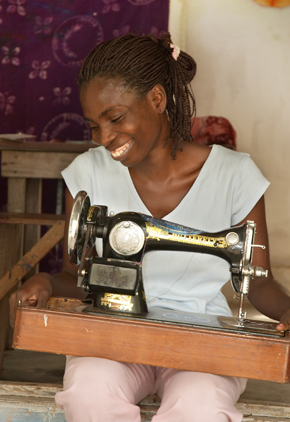If you are looking to make more sustainable lifestyle decisions, consider buying fair trade products. You might have noticed more items on the store shelf with the words "fair trade certified." This label means that those products are part of a system of buying and selling goods that is designed to promote greater equity between producers and consumers.
According to the Fair Trade Federation, the aims of the fair trade system are to create greater equity and partnership in the international trading system by:

The fair trade system has its roots in the late 1940s when a Mennonite volunteer first started bringing hand-made goods back from Puerto Rico for sale in the united states. That first fair trade exchange turned into the well-known purveyor of fair trade goods - Ten Thousand Villageswhich increased awareness of this type of exchange. Since then, fair trade exchanges have grown to a multibillion dollar part of the international economy, creating new economic opportunities for the developing world and leading to a broader appreciation for international goods.
By their nature, fair trade exchanges lead to producers getting paid a more equitable rate for the goods they provide compared to traditional wholesale changes where many producers make a few cents per unit of what they produce. This increase can lead to a higher standard of living, opportunities for gender equity and lowered barriers to entry into the world marketplace for less affluent countries and individuals. Now, more than just a market for handmade goods, fair trade has extended into commercial agriculture, textiles and furniture.
Large corporations are moving toward using more fair trade goods, companies like Starbucks have a line of fair trade coffees and recentlyBen & Jerry's announced that they will be moving to all fair trade goods. This move is considered especially notable by fair trade observers because the brand Ben & Jerry's was sold to Unilever which raised questions about whether or not the brand would continue to champion causes as they did when they were an independent entity.
TransFair USA which is the US certifying body for fair trade exchanges has also moved on to certifying textiles for use in clothing and linens. The first TransFair USA certified textiles are expected to go on the US Market by this spring. In the past fair trade textile alliances have also called for language to be included in World Trade Organization and United Nations resolutions in order to provide additional weight to the movement. This has had limited success however, without the cooperation of large governments like China.
Fair trade goods have seen continued growth in adoption all over the world and consumers have come to know the label as being indicative of sustainable commerce. Fair trade observers expect this trend to continue as awareness of these products and what the fair trade label means continues to grow.
According to the Fair Trade Federation, the aims of the fair trade system are to create greater equity and partnership in the international trading system by:
- Creating Opportunities for Economically and Socially Marginalized Producers
- Developing Transparent and Accountable Relationships
- Building Capacity
- Promoting Fair Trade
- Paying Promptly and Fairly
- Supporting Safe and Empowering Working Conditions
- Ensuring the Rights of Children
- Cultivating Environmental Stewardship
- Respecting Cultural Identity

The fair trade system has its roots in the late 1940s when a Mennonite volunteer first started bringing hand-made goods back from Puerto Rico for sale in the united states. That first fair trade exchange turned into the well-known purveyor of fair trade goods - Ten Thousand Villageswhich increased awareness of this type of exchange. Since then, fair trade exchanges have grown to a multibillion dollar part of the international economy, creating new economic opportunities for the developing world and leading to a broader appreciation for international goods.
By their nature, fair trade exchanges lead to producers getting paid a more equitable rate for the goods they provide compared to traditional wholesale changes where many producers make a few cents per unit of what they produce. This increase can lead to a higher standard of living, opportunities for gender equity and lowered barriers to entry into the world marketplace for less affluent countries and individuals. Now, more than just a market for handmade goods, fair trade has extended into commercial agriculture, textiles and furniture.
Large corporations are moving toward using more fair trade goods, companies like Starbucks have a line of fair trade coffees and recentlyBen & Jerry's announced that they will be moving to all fair trade goods. This move is considered especially notable by fair trade observers because the brand Ben & Jerry's was sold to Unilever which raised questions about whether or not the brand would continue to champion causes as they did when they were an independent entity.
TransFair USA which is the US certifying body for fair trade exchanges has also moved on to certifying textiles for use in clothing and linens. The first TransFair USA certified textiles are expected to go on the US Market by this spring. In the past fair trade textile alliances have also called for language to be included in World Trade Organization and United Nations resolutions in order to provide additional weight to the movement. This has had limited success however, without the cooperation of large governments like China.
Fair trade goods have seen continued growth in adoption all over the world and consumers have come to know the label as being indicative of sustainable commerce. Fair trade observers expect this trend to continue as awareness of these products and what the fair trade label means continues to grow.
I just found your blog tonight. I love fair trade and have supported it for years now:)
ReplyDeleteThat's great Melissa. Glad to have a new reader
ReplyDelete